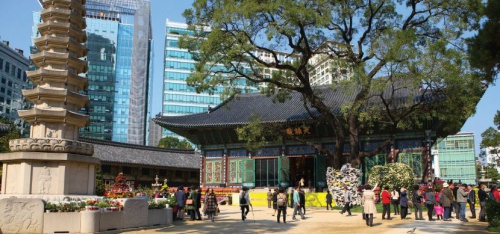Korea's Religious Places - 1.1.4 Jogyesa Temple (Seoul)
Jogyesa Temple (Seoul)
The headquarters temple for almost all of Korea is the Jogyesa Temple in downtown Seoul. There are several sects of Buddhism in Korea, but the dominant sect is called the Jogye Order (Jogyejong). The present-day Jogye Order is the standard-bearer for celibate Buddhism in Korea.
This temple goes back to the founding of the Joseon Dynasty and its move to Seoul in 1394. The temple was enlarged in 1910 at the beginning of the Japanese colonial era. There is Natural Monument no. 9, a large lacebark pine tree on the compound. It was planted by a traveler who brought it back from China, and is over 500 years old. Many temples have well-preserved and noteworthy trees and other plants on the compound. This speaks to the harmony of nature and religion—true of Confucianism and Shamanism as well as Buddhism in Korea.
Surrounding the entrance to Jogyesa Temple, on the main road of Anguk-dong in the heart of Seoul, are various shops selling Buddhist articles including clothes for monks and various images and other things for Buddhist worship. Often it is not only Buddhists who would buy such articles for temples and private worship—Shamans also like Buddhist images and artifacts to equip their Shaman shrines. The harmony of Shamanism and Buddhism is one of the main features of Korean religion.
Across the street from the entrance to Jogyesa Temple is a building housing administrative offices for the Jogye Order. There, one can arrange a temple stay at most of the temples nationwide. In recent years, the practice of staying overnight at a Buddhist temple has grown in popularity. Temples, by their nature, welcome sojourners. This has long been the case, but in recent years, temples have organized temple stays for foreigners and Koreans alike, where one can stay one night, or several nights, and experience a taste of monastic life at a temple.
